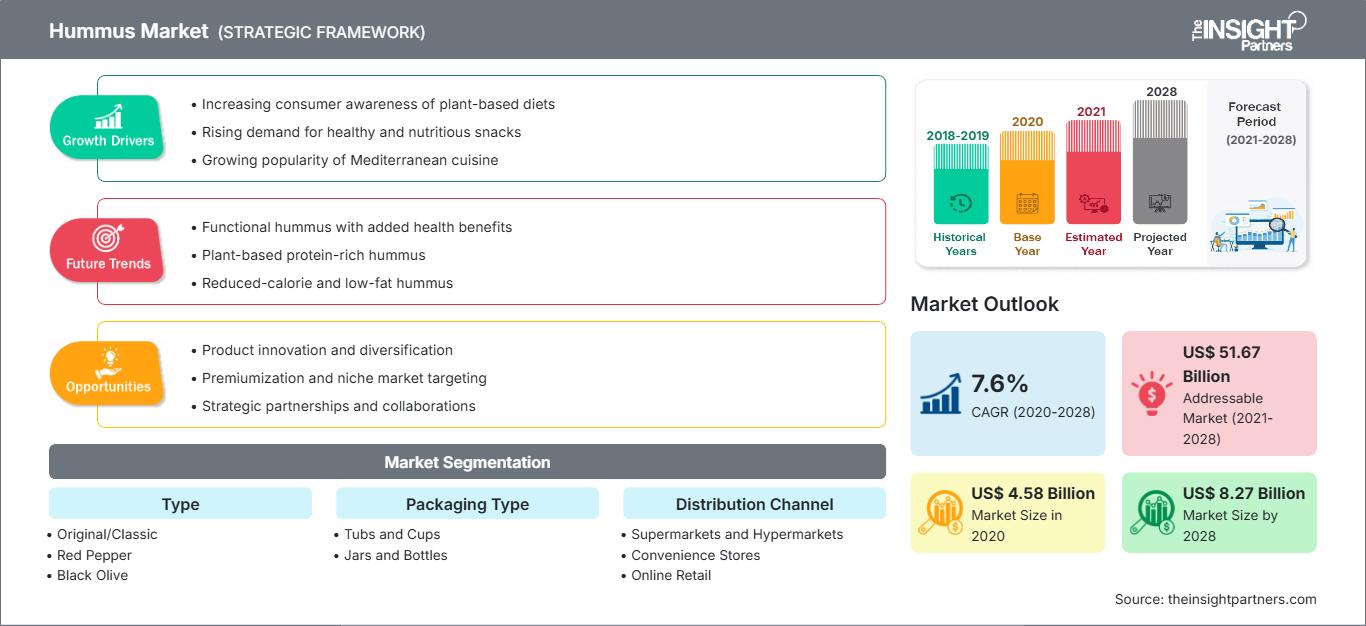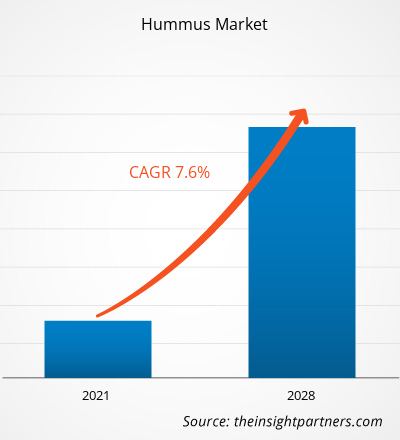Il mercato dell'hummus è stato valutato a 4.577,35 milioni di dollari nel 2020 e si prevede che raggiungerà gli 8.267,07 milioni di dollari entro il 2028; si prevede una crescita a un CAGR del 7,6% dal 2021 al 2028.
L'hummus è una salsa e crema spalmabile mediorientale molto nota, ricca di minerali, vitamine, proteine e fibre. Tutti gli ingredienti principali dell'hummus: ceci, aglio, semi di sesamo o pasta (tahina) e olio d'oliva sono riconosciuti come superfood. I ceci sono ricchi di ferro, fosforo e vitamine del gruppo B. La tahina ha un alto contenuto di zinco, calcio, rame e fosforo. Il succo di limone è un'ottima fonte di vitamina C e antiossidanti. L'aglio, che aggiunge sapore all'hummus, è arricchito con antiossidanti, oligoelementi e vitamine.
Si prevede che il mercato dell'hummus nella regione Asia-Pacifico crescerà al CAGR più elevato tra il 2021 e il 2028. Con la crescita economica e la crescente prevalenza di varie malattie, lo stile di vita e i modelli di consumo sono cambiati in paesi come India, Cina e Giappone. Inoltre, la tendenza al veganismo è in crescita, con la crescente consapevolezza della necessità di proteggere l'ambiente. La crescente domanda di proteine vegetali e la crescente attenzione alla salute sono i principali fattori che guidano la crescita del mercato nella regione. Anche l'Europa sta assistendo a un'elevata domanda di proteine vegetali, con la crescente adozione del veganismo in Europa, soprattutto nel Regno Unito. I produttori di hummus stanno inoltre ampliando le loro linee di prodotti lanciando varianti biologiche e varietà innovative e saporite.
La pandemia di COVID-19 ha ostacolato le performance del mercato dell'hummus, principalmente a causa dell'interruzione della produzione e delle catene di approvvigionamento delle materie prime, delle incertezze meteorologiche e di altri motivi. L'epidemia ha compromesso l'efficienza operativa e le catene del valore a causa dell'improvvisa chiusura dei confini nazionali e internazionali. Tuttavia, con molte economie impegnate a riprendere e normalizzare le proprie attività, si presume che la domanda di hummus aumenterà nel prossimo futuro. Inoltre, la crescente preferenza per uno stile di vita sano e la maggiore attenzione verso alimenti che rafforzano il sistema immunitario continueranno a contribuire alla crescita del mercato dell'hummus nei prossimi anni. Inoltre, è probabile che i produttori di hummus sfruttino i canali di distribuzione online per espandere il business. Ciò è dovuto principalmente alla crescente preferenza di ordinare prodotti di consumo online per evitare assembramenti e rispettare le norme di distanziamento sociale. I canali di vendita al dettaglio di prodotti alimentari operano già nel rispetto di rigide linee guida igienico-sanitarie; tuttavia, molti di essi stanno adottando ulteriori precauzioni per ridurre il contatto interpersonale. Alcune delle misure di sicurezza adottate dalle aziende includono la limitazione del contatto diretto con camionisti e altri visitatori, la comunicazione e l'evidenziazione delle corrette pratiche igieniche, l'esecuzione di sanificazioni complete e l'eliminazione delle possibilità di contatto del personale durante i cambi turno.
Personalizza questo rapporto in base alle tue esigenze
Potrai personalizzare gratuitamente qualsiasi rapporto, comprese parti di questo rapporto, o analisi a livello di paese, pacchetto dati Excel, oltre a usufruire di grandi offerte e sconti per start-up e università
Mercato dell'hummus: Approfondimenti strategici

-
Ottieni le principali tendenze chiave del mercato di questo rapporto.Questo campione GRATUITO includerà l'analisi dei dati, che vanno dalle tendenze di mercato alle stime e alle previsioni.
L'hummus è una nota salsa e crema spalmabile mediorientale ad alto contenuto di minerali, vitamine, proteine e fibre. Tutti gli ingredienti principali dell'hummus - ceci, aglio, semi di sesamo o pasta (tahina) e olio d'oliva - sono riconosciuti come superfood. I ceci sono ricchi di ferro, fosforo e vitamine del gruppo B. La tahina ha un alto contenuto di zinco, calcio, rame e fosforo. Il succo di limone è un'ottima fonte di vitamina C e antiossidanti. L'aglio, che aggiunge sapore all'hummus, è ricco di antiossidanti e contiene molti oligoelementi e vitamine. La crescente prevalenza di malattie come ictus, cardiopatia ischemica, broncopneumopatia cronica ostruttiva e diabete mellito sta attirando l'attenzione delle persone verso alimenti sani, soprattutto nelle regioni sviluppate e in via di sviluppo. L'hummus ha trovato spazio anche nei negozi al dettaglio e nei supermercati grazie alla diversificazione dei canali di distribuzione. È naturalmente privo di allergeni e sostanze irritanti comuni come frutta a guscio, glutine e latticini. Può anche essere utilizzato per sostituire condimenti cremosi per insalata, maionese, panna acida, salsa ranch e altri condimenti in ricette come panini, pane, cracker e patatine. Inoltre, l'aumento degli standard economici e del reddito disponibile, nonché la diversificazione delle preferenze alimentari, aumentano la domanda di alimenti sani come l'hummus. Pertanto, i benefici conferiti dall'hummus, come una migliore salute digestiva, una corretta perdita di peso, un migliore controllo della glicemia, proprietà antinfiammatorie e un minor rischio di malattie cardiache, ne stanno rafforzando la domanda.
Approfondimenti sulle tipologie
In base alla tipologia, il mercato dell'hummus è segmentato in originale/classico, al peperone rosso, alle olive nere, ai fagioli bianchi e altri. Gli altri segmenti includono principalmente hummus di barbabietola, fagioli neri, lupini, edmame, jalapeño, aglio nero e lenticchie gialle. La barbabietola arrostita conferisce dolcezza e un vivace colore rosa all'hummus. L'hummus di barbabietola è una ricetta che richiede poca manutenzione e ha un aspetto molto suggestivo. I fagioli neri sono una varietà piccola e lucida dei fagioli comuni, e sono altamente nutrienti in quanto contengono antiossidanti, fibre, proteine e carboidrati. I fagioli neri e i lupini vengono utilizzati in sostituzione dei ceci nelle rispettive varietà di hummus. Le ricette che includono questi fagioli possono essere incluse nella dieta chetogenica, a seconda del limite di carboidrati. I lupini e le lenticchie gialle danno un tocco di colore all'hummus tradizionale, oltre a conferire un sapore piccante. I peperoncini jalapeño sono di un verde brillante e aggiungono freschezza all'hummus. Aumentano anche la piccantezza dell'hummus tradizionale. Inoltre, l'hummus all'aglio nero è arricchito con vari nutrienti e antiossidanti. Inoltre, l'aglio nero conferisce all'hummus un sapore caldo e delicato.
Alcuni dei principali attori del mercato dell'hummus sono Bakkavor Group; Cedar's Mediterranean Foods Inc.; Haliburton International Foods; Strauss Group; Tribe Hummus; Hope Foods, LLC; Fountain of Health; Hummus Goodness; Boar's Head Brand; e Lantana Foods. I principali attori del mercato si stanno concentrando su strategie come fusioni e acquisizioni e lanci di prodotti per espandere la presenza geografica e la base di consumatori.
In evidenza nel rapporto
Tendenze progressive nel settore dell'hummus
- per aiutare gli operatori a sviluppare strategie efficaci a lungo termine
- Strategie di crescita aziendale adottate dalle aziende per garantire la crescita nei mercati sviluppati e in via di sviluppo
- Analisi quantitativa del mercato globale dell'hummus dal 2019 al 2028
- Stima della domanda di hummus in vari settori
- Analisi PEST per illustrare l'efficacia di acquirenti e fornitori che operano nel settore nel prevedere la crescita del mercato
- Sviluppi recenti per comprendere lo scenario competitivo del mercato e la domanda di hummus
- Tendenze e prospettive di mercato insieme ai fattori che guidano e frenano la crescita del mercato dell'hummus
- Comprensione delle strategie che sostengono l'interesse commerciale per quanto riguarda la crescita del mercato globale dell'hummus, aiutando nel processo decisionale
- Dimensioni del mercato dell'hummus in vari nodi del mercato
- Panoramica dettagliata e segmentazione del mercato globale dell'hummus e delle sue dinamiche industriali
- Dimensioni del mercato dell'hummus in varie regioni con promettenti opportunità di crescita
Le tendenze regionali e i fattori che influenzano il mercato dell'hummus durante il periodo di previsione sono stati ampiamente spiegati dagli analisti di The Insight Partners. Questa sezione analizza anche i segmenti e la geografia del mercato dell'hummus in Nord America, Europa, Asia-Pacifico, Medio Oriente e Africa, America Meridionale e Centrale.
Ambito del rapporto sul mercato dell'hummus
| Attributo del rapporto | Dettagli |
|---|---|
| Dimensioni del mercato in 2020 | US$ 4.58 Billion |
| Dimensioni del mercato per 2028 | US$ 8.27 Billion |
| CAGR globale (2020 - 2028) | 7.6% |
| Dati storici | 2018-2019 |
| Periodo di previsione | 2021-2028 |
| Segmenti coperti |
By Tipo
|
| Regioni e paesi coperti |
Nord America
|
| Leader di mercato e profili aziendali chiave |
|
Densità degli attori del mercato dell'hummus: comprendere il suo impatto sulle dinamiche aziendali
Il mercato dell'hummus è in rapida crescita, trainato dalla crescente domanda da parte dei consumatori finali, dovuta a fattori quali l'evoluzione delle preferenze dei consumatori, i progressi tecnologici e una maggiore consapevolezza dei benefici del prodotto. Con l'aumento della domanda, le aziende stanno ampliando la propria offerta, innovando per soddisfare le esigenze dei consumatori e sfruttando le tendenze emergenti, alimentando ulteriormente la crescita del mercato.

- Ottieni il Mercato dell'hummus Panoramica dei principali attori chiave
- Originale/Classico
- Peperone rosso
- Olive nere
- Fagioli bianchi
- Altri
Mercato dell'hummus, per tipo di confezione
- Vaschette e bicchieri
- Vasi e bottiglie
- Altri
Mercato dell'hummus, per tipo di confezione
- Supermercati e ipermercati
- Negozi di alimentari
- Vendita al dettaglio online
- Altri
Profili aziendali
- Bakkavor Group
- Cedar’s Mediterranean Foods Inc.
- Haliburton International Foods
- Strauss Group
- Tribe Hummus
- Hope Foods, LLC
- Fountain of Health
- Hummus Goodness
- Boar’s Head Brand
- Lantana Foods
- Analisi storica (2 anni), anno base, previsione (7 anni) con CAGR
- Analisi PEST e SWOT
- Valore/volume delle dimensioni del mercato - Globale, Regionale, Nazionale
- Industria e panorama competitivo
- Set di dati Excel
Report recenti
Testimonianze
Motivo dell'acquisto
- Processo decisionale informato
- Comprensione delle dinamiche di mercato
- Analisi competitiva
- Analisi dei clienti
- Previsioni di mercato
- Mitigazione del rischio
- Pianificazione strategica
- Giustificazione degli investimenti
- Identificazione dei mercati emergenti
- Miglioramento delle strategie di marketing
- Aumento dell'efficienza operativa
- Allineamento alle tendenze normative






















 Ottieni un campione gratuito per - Mercato dell'hummus
Ottieni un campione gratuito per - Mercato dell'hummus